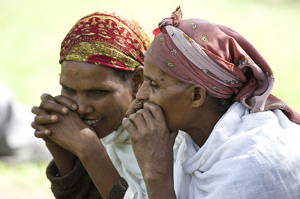Today’s post was written to support Changemakers‘ Health Mothers Strong World maternal health competition. It was also published on the Maternal Task Force blog.
Standing under the dusty flap of the clinic tent, Abeba blinked hard, willing her tears to hold. She focused her eyes on a dusty pebble in the sand.
The nurse-practitioner’s voice continued to scold.
Abeba picked up snippets of the English-accented words, “High risk pregnancy,” “preeclampsia.” The baby in her belly kicked Abeba hard under her left rib. Dahney, her two-year old, started to wail.
The nurse frowned, handed Abeba a page of printed instructions and continued to drone on.
Why did I come here? Abeba thought to herself. This woman’s not going to help me. Soon I’ll be mother of four—and she treats me like a child.
Education: The key to reducing maternal death worldwide
Each year more than half a million women—most in developing countries—die in childbirth. Tragically, most maternal deaths could be easily—and inexpensively—prevented. All it takes is very basic healthcare and education.
But maternal health education is broken. The system fails mothers and midwives, says Faatemehzahraa Ahmadi. A young Iranian woman who works for Alzahra, Ahmadi believes maternal health education needs an overhaul.
Learners aren’t “empty pots” waiting to be filled.
In her proposal to Young Champions of Maternal Health—a project funded by Changemakers—Ahmadi suggests simple but radical educational precepts:
- Stop talking “at” learners.
- Cease treating students—in this case, pregnant women and local midwives—like empty pots waiting to be filled.
- Envision teachers and learners as co-investigators.
Ahmadi’s proposal is based on the work of Brazilian educator, Paulo Freire.
I felt immediately drawn to her project—perhaps because, as a marketing copywriter, I see parallels between Freire’s system and new media marketing techniques.
Using conversation to educate and build relationship
Elements that support digital media marketing are at play in Freire’s educational model. Both systems require you to:
Speak your audience’s language. The first step in Freire’s educational system gets “the teacher mingling among the community,” writes Ahmadi, “asking questions of the people and gathering a list of words used in their daily lives.” This sounds a lot like first-step work for good marketers and copywriters.
Teach and persuade with dialogue—not monologue. With traditional pedagogy, teachers “stand and deliver” information to meek, compliant students. The model echoes traditional “push” marketing’s one-way conversation. But today conventional marketing is imploding as consumers demand engagement and refuse to remain passive vessels. New media marketing—and Ahmadi’s educational proposal—rely on dialogue.
Offer crowd-sourced solutions. In Freire’s flexible system, social intermingling lets teachers and students develop tailored teaching methods. A curriculum should include regionalisms, village customs, local language and traditional ritual. I see analogies in new marketing methods born of social media’s wisdom-of-the-crowd.
Take a look at Faatemehzahraa Ahmadi’s Young Champions proposal. I think dialogue-based education will serve Abeba better than authoritative models. What do you think?
Photo courtesy of babasteve.


Leave a comment.